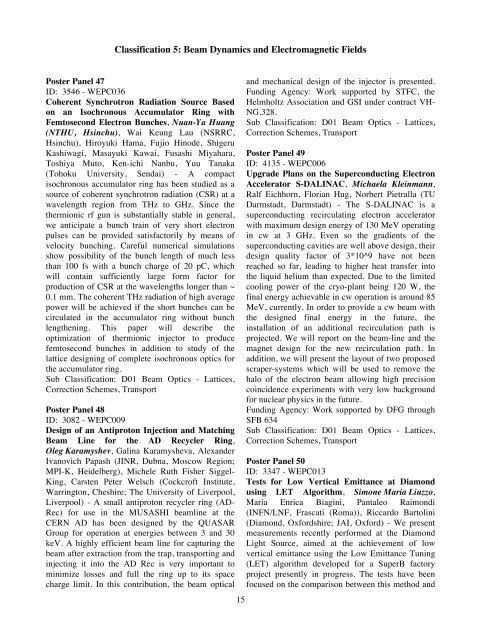Abstracts Brochure - 2nd International Particle Accelerator Conference
Abstracts Brochure - 2nd International Particle Accelerator Conference
Abstracts Brochure - 2nd International Particle Accelerator Conference
Create successful ePaper yourself
Turn your PDF publications into a flip-book with our unique Google optimized e-Paper software.
�<br />
Classification 5: Beam Dynamics and Electromagnetic Fields<br />
Poster Panel 47<br />
ID: 3546 - WEPC036<br />
Coherent Synchrotron Radiation Source Based<br />
on an Isochronous Accumulator Ring with<br />
Femtosecond Electron Bunches, Nuan-Ya Huang<br />
(NTHU, Hsinchu), Wai Keung Lau (NSRRC,<br />
Hsinchu), Hiroyuki Hama, Fujio Hinode, Shigeru<br />
Kashiwagi, Masayuki Kawai, Fusashi Miyahara,<br />
Toshiya Muto, Ken-ichi Nanbu, Yuu Tanaka<br />
(Tohoku University, Sendai) - A compact<br />
isochronous accumulator ring has been studied as a<br />
source of coherent synchrotron radiation (CSR) at a<br />
wavelength region from THz to GHz. Since the<br />
thermionic rf gun is substantially stable in general,<br />
we anticipate a bunch train of very short electron<br />
pulses can be provided satisfactorily by means of<br />
velocity bunching. Careful numerical simulations<br />
show possibility of the bunch length of much less<br />
than 100 fs with a bunch charge of 20 pC, which<br />
will contain sufficiently large form factor for<br />
production of CSR at the wavelengths longer than ~<br />
0.1 mm. The coherent THz radiation of high average<br />
power will be achieved if the short bunches can be<br />
circulated in the accumulator ring without bunch<br />
lengthening. This paper will describe the<br />
optimization of thermionic injector to produce<br />
femtosecond bunches in addition to study of the<br />
lattice designing of complete isochronous optics for<br />
the accumulator ring.<br />
Sub Classification: D01 Beam Optics - Lattices,<br />
Correction Schemes, Transport<br />
Poster Panel 48<br />
ID: 3082 - WEPC009<br />
Design of an Antiproton Injection and Matching<br />
Beam Line for the AD Recycler Ring,<br />
Oleg Karamyshev, Galina Karamysheva, Alexander<br />
Ivanovich Papash (JINR, Dubna, Moscow Region;<br />
MPI-K, Heidelberg), Michele Ruth Fisher Siggel-<br />
King, Carsten Peter Welsch (Cockcroft Institute,<br />
Warrington, Cheshire; The University of Liverpool,<br />
Liverpool) - A small antiproton recycler ring (AD-<br />
Rec) for use in the MUSASHI beamline at the<br />
CERN AD has been designed by the QUASAR<br />
Group for operation at energies between 3 and 30<br />
keV. A highly efficient beam line for capturing the<br />
beam after extraction from the trap, transporting and<br />
injecting it into the AD Rec is very important to<br />
minimize losses and full the ring up to its space<br />
charge limit. In this contribution, the beam optical<br />
15<br />
and mechanical design of the injector is presented.<br />
Funding Agency: Work supported by STFC, the<br />
Helmholtz Association and GSI under contract VH-<br />
NG.328.<br />
Sub Classification: D01 Beam Optics - Lattices,<br />
Correction Schemes, Transport<br />
Poster Panel 49<br />
ID: 4135 - WEPC006<br />
Upgrade Plans on the Superconducting Electron<br />
<strong>Accelerator</strong> S-DALINAC, Michaela Kleinmann,<br />
Ralf Eichhorn, Florian Hug, Norbert Pietralla (TU<br />
Darmstadt, Darmstadt) - The S-DALINAC is a<br />
superconducting recirculating electron accelerator<br />
with maximum design energy of 130 MeV operating<br />
in cw at 3 GHz. Even so the gradients of the<br />
superconducting cavities are well above design, their<br />
design quality factor of 3*10^9 have not been<br />
reached so far, leading to higher heat transfer into<br />
the liquid helium than expected. Due to the limited<br />
cooling power of the cryo-plant being 120 W, the<br />
final energy achievable in cw operation is around 85<br />
MeV, currently. In order to provide a cw beam with<br />
the designed final energy in the future, the<br />
installation of an additional recirculation path is<br />
projected. We will report on the beam-line and the<br />
magnet design for the new recirculation path. In<br />
addition, we will present the layout of two proposed<br />
scraper-systems which will be used to remove the<br />
halo of the electron beam allowing high precision<br />
coincidence experiments with very low background<br />
for nuclear physics in the future.<br />
Funding Agency: Work supported by DFG through<br />
SFB 634<br />
Sub Classification: D01 Beam Optics - Lattices,<br />
Correction Schemes, Transport<br />
Poster Panel 50<br />
ID: 3347 - WEPC013<br />
Tests for Low Vertical Emittance at Diamond<br />
using LET Algorithm, Simone Maria Liuzzo,<br />
Maria Enrica Biagini, Pantaleo Raimondi<br />
(INFN/LNF, Frascati (Roma)), Riccardo Bartolini<br />
(Diamond, Oxfordshire; JAI, Oxford) - We present<br />
measurements recently performed at the Diamond<br />
Light Source, aimed at the achievement of low<br />
vertical emittance using the Low Emittance Tuning<br />
(LET) algorithm developed for a SuperB factory<br />
project presently in progress. The tests have been<br />
focused on the comparison between this method and


